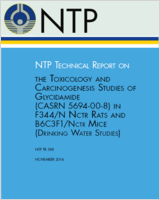This is a work of the US government and distributed under the terms of the Public Domain
NCBI Bookshelf. A service of the National Library of Medicine, National Institutes of Health.
National Toxicology Program. NTP Technical Report on the Toxicology and Carcinogenesis Studies of Glycidamide (CASRN 5694-00-8) in F344/N Nctr Rats and B6C3F1/Nctr Mice (Drinking Water Studies): Technical Report 588 [Internet]. Research Triangle Park (NC): National Toxicology Program; 2014 Nov.

NTP Technical Report on the Toxicology and Carcinogenesis Studies of Glycidamide (CASRN 5694-00-8) in F344/N Nctr Rats and B6C3F1/Nctr Mice (Drinking Water Studies): Technical Report 588 [Internet].
Show detailsJ.1. Methods
J.1.1. Bacterial Mutagenicity Assay
Testing was performed as reported by Zeiger et al.75 Glycidamide was sent to the testing laboratory and coded prior to testing. It was incubated with the Salmonella typhimurium tester strains (TA98, TA100) either in buffer or S9 mix (metabolic activation enzymes and cofactors from Aroclor 1254-induced male Sprague Dawley rats) for 20 minutes at 37°C. Top agar supplemented with l-histidine and d-biotin was added, and the contents of the tubes were mixed and poured onto the surfaces of minimal glucose agar plates. Histidine-independent mutant colonies arising on these plates were counted following a 2-day incubation at 37°C.
Each trial consisted of triplicate plates of concurrent positive and negative controls and of at least five doses of glycidamide. In the absence of toxicity, the high dose was limited to 10,000 μg/plate. Trials that gave a positive response were repeated.
In this assay, a positive response is defined as a reproducible, dose-related increase in histidine-independent (revertant) colonies in any one strain/activation combination. An equivocal response is defined as an increase in revertants that is not dose-related, is not reproducible, or is not of sufficient magnitude to support a determination of mutagenicity. A negative response is obtained when no increase in revertant colonies is observed following chemical treatment. There is no minimum percentage or fold-increase required for a chemical to be judged positive or weakly positive.
J.2. Results
Glycidamide (concentration range, 100–10,000 μg/plate) was strongly mutagenic in Salmonella typhimurium strain TA100, with and without exogenous metabolic activation (S9 mix); addition of S9 slightly enhanced the mutagenic response compared to the trials conducted without S9, but the mutagenic response was extremely strong under both activation conditions (Table J-1). In contrast, no significant mutagenic activity was seen in strain TA98, with or without S9.
Table J-1Mutagenicity of Glycidamide in Salmonella typhimuriuma
| Strain | Dose (µg/plate) | Without S9 | Without S9 | With 10% Rat S9 | With 10% Rat S9 |
|---|---|---|---|---|---|
| Study performed at Bioreliance Corporation | |||||
| TA100 | |||||
| 0 | 148 ± 21.0 | 154 ± 13.0 | 149 ± 6.0 | 176 ± 3.0 | |
| 100 | 192 ± 17.0 | 232 ± 8.0 | 184 ± 22.0 | 238 ± 5.0 | |
| 333 | 307 ± 6.0 | 512 ± 40.0 | 373 ± 7.0 | 400 ± 41.0 | |
| 1000 | 613 ± 26.0 | 589 ± 129.0 | 621 ± 92.0 | 1,024 ± 15.0 | |
| 3333 | 1,022 ± 15.0 | 1,267 ± 18.0 | 1,055 ± 22.0 | 1,193 ± 80.0 | |
| 10000 | 1,210 ± 42.0 | 1,591 ± 24.0 | 1,534 ± 55.0 | 1,730 ± 127.0 | |
| Trial summary | Positive | Positive | Positive | Positive | |
| Positive controlb | 538 ± 9.0 | 532 ± 38.0 | 1,027 ± 34.0 | 693 ± 13.0 | |
| TA98 | |||||
| 0 | 16 ± 2.0 | 30 ± 2.0 | |||
| 100 | 22 ± 1.0 | 36 ± 3.0 | |||
| 333 | 18 ± 2.0 | 27 ± 0.0 | |||
| 1000 | 21 ± 3.0 | 33 ± 1.0 | |||
| 3333 | 26 ± 1.0 | 37 ± 2.0 | |||
| 10000 | 27 ± 1.0 | 34 ± 7.0 | |||
| Trial summary | Negative | Negative | |||
| Positive control | 76 ± 25.0 | 581 ± 5.0 | |||
- a
Data are presented as revertants/plate (mean ± standard error) from three plates. 0 μg/plate was the solvent control.
- b
The positive controls in the absence of metabolic activation were sodium azide (TA100) and 4-nitro-o-phenylenediamine (TA98). The positive control for metabolic activation with all strains was 2-aminoanthracene.
- Genetic Toxicology - NTP Technical Report on the Toxicology and Carcinogenesis S...Genetic Toxicology - NTP Technical Report on the Toxicology and Carcinogenesis Studies of Glycidamide (CASRN 5694-00-8) in F344/N Nctr Rats and B6C3F1/Nctr Mice (Drinking Water Studies)
- Rhinomonas reticulata var. atrorosea isolate CRY07.ecy03 Mg-protoporyphyrin IX c...Rhinomonas reticulata var. atrorosea isolate CRY07.ecy03 Mg-protoporyphyrin IX chelatase (chlI) gene, partial cds; plastidgi|1557899048|gb|MG646502.1|Nucleotide
- Homo sapiens clone UGLsupplD, mRNA sequenceHomo sapiens clone UGLsupplD, mRNA sequencegi|155574095|gb|DQ656043.2|Nucleotide
- Apioideae internal transcribed spacer 1, 5.8S ribosomal RNA gene, and internal t...Apioideae internal transcribed spacer 1, 5.8S ribosomal RNA gene, and internal transcribed spacer 2, complete sequence.PopSet: 165911377PopSet
- Amycolatopsis methanolica 239Amycolatopsis methanolica 239Amycolatopsis methanolica 239 Genome sequencing and assemblyBioProject
Your browsing activity is empty.
Activity recording is turned off.
See more...